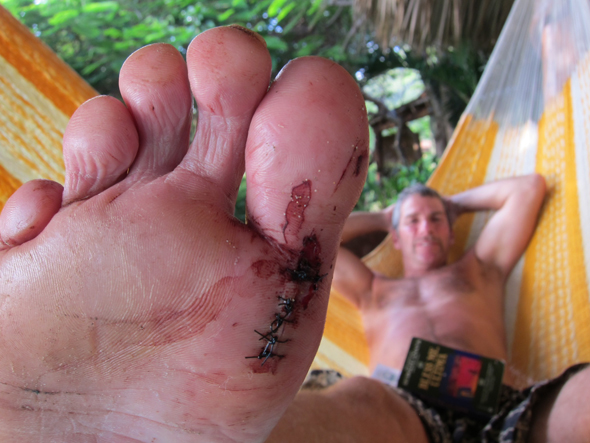Surf Survival: A Boot Camp for Aspiring Watermen
ER Doc and author, Andrew Nathanson, tells the Harmony Blog about the surfing injury that inspired him to write a book on how to survive fin cuts, sting ray barbs to the shin and related big wave beat downs that can come with surfing.
Andrew Nathanson, an ER doctor and avid waterman, is probably one of the few surfers who’s had a eureka moment thanks to the painful experience of stepping on a sea urchin. A medical student in LA at the time, Nathanson realized that “there wasn’t a whole lot of literature out there” on marine-based injuries. “It got me thinking, What are the risks of injuries in the sport? So I did a study first on windsurfing injuries and then got that published, and then I did some more studies on surfing injuries and all the while I was doing emergency medicine.”
One thing led to the next, and several years later, a colleague who was also a member of the wilderness medicine society approached him at a conference with the idea of writing a book for surfers. In collaborated with a third author, Mark Renneker, who’s a founder of the Surfers’ Medical Association—and one of the first guys to surf at Mavericks—they published, in 2011, Surf Survival: The Surfers’ Health Handbook. It covers things including: how to fix cuts, how to deal with infections and how to make splints with limited resources in remote locations. So how do you jerry-rig a sling? “Say you dislocated your shoulder. You can take the bottom of a T-shirt and put your arm across and take the end of your T-shirt towards your head and pin it up with a safety pin.”
Nathanson notes, there’s a lot of disinformation out there. “Urinating on a jellyfish sting”—for instance. “The only person that gets relief is the person providing the medical care.” And while he says the most common surfing injury is being hit on your head by your surfboard, there are a variety of other scenarios, and it’s especially helpful to be prepared in relation to where you’re surfing. “Each place has different potential hazards. In Hawaii you have to be more mindful about hitting a coral reef. Down in Nosara, stingray stings are quite common.”
With all of this research, Nathanson realized that beginner and expert surfers alike still have a lot to learn so in 2012, he started the Surf Survival Camp hosted at the Harmony Hotel to teach these skills to surfers who wanted to hone their waterman skills. The camp is for surfers of any level. “For beginners,” he says, “there’s a pretty steep learning curve in terms of understanding the marine environment: what the bottom is like, what the rip currents are, and how to get in and out of the water with a big shore break.” And more advanced surfers still can use lots of pointers. For instance, he noted, they can often still be reminded about “sanding off the sharp, trailing edges of the fins, and rounding off unnecessarily pointy surfboard tips.”
During the week-long session, Nathanson will be covering everything from basic preparedness to more complicated safety techniques. This will be the second year that Harmony Hotel’s hosted the camp, which involves a one-and-a-half-hour lecture every day, followed by a hands-on component where campers will be practicing what they’ve learned. Before class each day, Nathanson’s wife will lead a morning stretch, followed by surfing. And when lessons are done? The afternoon’s free, for the most part, for campers to surf and enjoy Nosara.
So what’s the worst injury Andrew Nathanson’s ever received? “I’ve had a couple of times where I got cuts on my face from my own surfboard right above my eyebrow, matching eyebrow wounds.” And twice, in pursuit of the surf, just before a hurricane swell, he’s been whacked in the head by his surfboard. “They weren’t that bad,” he says of the injuries. “I had my son glue them up with surgical adhesive, which is a supergluey kind of stuff—medical superglue, basically.”
 For a chance to win a free spot at the Surf Survival Camp and a 7-night stay at the Harmony Hotel, tell us your best Surf Beat Down Story here.
For a chance to win a free spot at the Surf Survival Camp and a 7-night stay at the Harmony Hotel, tell us your best Surf Beat Down Story here.






